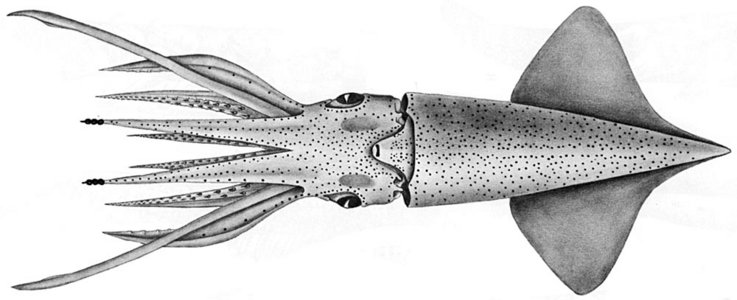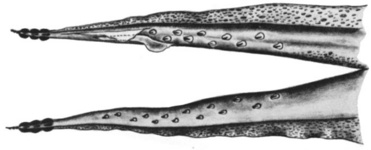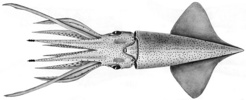Abraliopsis felis
Kotaro TsuchiyaIntroduction
A. felis is the only cool-temperate species in the genus Abraliopsis. It is found in the Kuroshio-Oyashio transition zone and the California Current.
Characteristics
- Tentacle clubs
- Two series of hooks on manus; ventral hooks moderately larger (in a relative sense) than dorsal hooks.
- Carpal flap absent; aboral keel short, narrow.
- Arms
- Arms IV intermediate in lenght; ALI IV = 40-65.
- Arms with 12 to 22 hooks and 12-22 suckers (excl. arm IV).
- Hectocotylus
- Hectocotylus with two subequal-sized offset flaps: proximal flap on ventral margin, distal flap on dorsal margin.
- Hectocotylus with two subequal-sized offset flaps: proximal flap on ventral margin, distal flap on dorsal margin.
- Head
- Beaks: Descriptions can be found here: Lower beak; upper beak.
- Beaks: Descriptions can be found here: Lower beak; upper beak.
- Integumental Photophores
- Ventral mantle and head with scattered arrangement of integumental organs.
Comments
A. felis is the only species, with the possible exception of A. hoylei, characterized by having a scattered arrangement of integument photophores and lacking the carpal flap.
Distribution
Vertical Distribution
In the Kuroshio-Oyashio transition zone, this species were occurred abundantly between 0-50m during night.
Geographical Distribution
A. felis is the only cool-temperate species in the genus Abraliopsis. Its distribution extends from the northern Northwest Pacific at 145° E along the Kuroshio-Oyashio transition zone, eastward to northwestern coast of America, and in the California Current southward to northern Baja California (Young, 1972).
References
Tsuchiya, K. 1993. Distribution and zoogeography of the family Enoploteuthidae in the Northwest Pacific. In: Okutani, T., O?Dor, R. K. and Kubodera, T. (eds.) 1993. Recent advances in fisheries biology (Tokai University Press. Tokyo). pp. 571-585.
Okutani, T. and McGowan, J.A. 1969. Systematics, Distribution, and abundance ofthe epiplanktonic squid (Cephalopoda, Decapoda) larvae of the California Current. Bull. Scripps Inst. Oceanogr., 14:1-90.
Young, R.E. 1972. The systematics and areal distribution of pelagic cephalopods from the sea off southern California. Smiths. Contr. Zool., 97:1-159.
About This Page

Tokyo University of Fisheries, Tokyo, Japan
Page copyright © 2011
All Rights Reserved.
- Content changed 01 August 2009
Citing this page:
Tsuchiya, Kotaro. 2011. Abraliopsis felis . Version 03 March 2011 (under construction). http://tolweb.org/Abraliopsis_felis/19686/2011.03.03 in The Tree of Life Web Project, http://tolweb.org/











 Go to quick links
Go to quick search
Go to navigation for this section of the ToL site
Go to detailed links for the ToL site
Go to quick links
Go to quick search
Go to navigation for this section of the ToL site
Go to detailed links for the ToL site